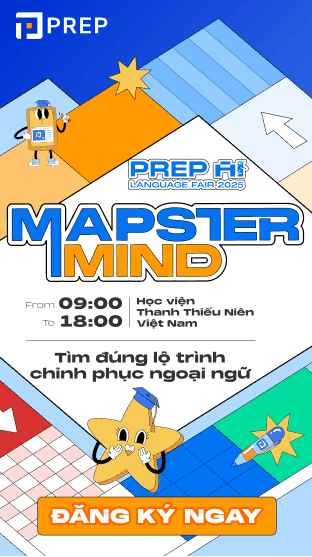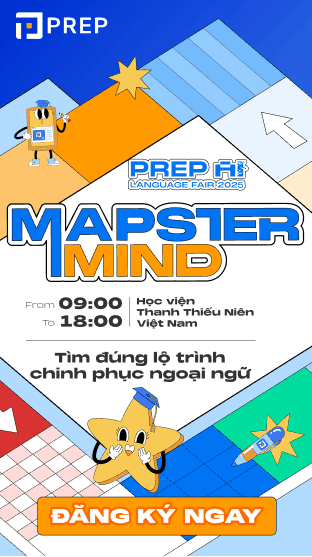Đề bài và đáp án chi tiết Cambridge IELTS 15 Passage 1 Could urban engineers learn from dance
Trong kỳ thi IELTS, phần Đọc (Reading) không chỉ kiểm tra khả năng hiểu văn bản mà còn yêu cầu thí sinh áp dụng các kỹ năng đọc hiểu và xử lý thông tin nhanh chóng. Trong Cambridge 15, bài đọc Could urban engineers learn from dance đặt ra một câu hỏi hấp dẫn về mối liên hệ giữa nghệ thuật múa và ngành kỹ thuật đô thị, đặc biệt là cách các kỹ sư đô thị có thể học hỏi từ các nguyên lý chuyển động trong múa để thiết kế các không gian công cộng hiệu quả và năng động hơn. Hãy cùng Prep khám phá chi tiết đề bài, phân tích đáp án và cung cấp các chiến lược làm bài hiệu quả giúp bạn nắm bắt thông tin và đạt điểm cao trong phần Reading của kỳ thi IELTS nhé!

I. Đề bài Cambridge IELTS 15 Cambridge Passage 1 Could urban engineers learn from dance
READING PASSAGE 1
You should spend about 20 minutes on Questions 1-13 which are based on Reading Passage 1 below.
Could urban engineers learn from dance?
A
The way we travel around cities has a major impact on whether they are sustainable. Transportation is estimated to account for 30% of energy consumption in most of the world’s most developed nations, so lowering the need for energy-using vehicles is essential for decreasing the environmental impact of mobility. But as more and more people move to cities, it is important to think about other kinds of sustainable travel too. The ways we travel affect our physical and mental health, our social lives, our access to work and culture, and the air we breathe. Engineers are tasked with changing how we travel round cities through urban design, but the engineering industry still works on the assumptions that led to the creation of the energy-consuming transport systems we have now: the emphasis placed solely on efficiency, speed, and quantitative data. We need radical changes, to make it healthier, more enjoyable, and less environmentally damaging to travel around cities.
B
Dance might hold some of the answers. That is not to suggest everyone should dance their way to work, however healthy and happy it might make us, but rather that the techniques used by choreographers to experiment with and design movement in dance could provide engineers with tools to stimulate new ideas in city-making. Richard Sennett, an influential urbanist and sociologist who has transformed ideas about the way cities are made, argues that urban design has suffered from a separation between mind and body since the introduction of the architectural blueprint.
C
Whereas medieval builders improvised and adapted construction through their intimate knowledge of materials and personal experience of the conditions on a site, building designs are now conceived and stored in media technologies that detach the designer from the physical and social realities they are creating. While the design practices created by these new technologies are essential for managing the technical complexity of the modern city, they have the drawback of simplifying reality in the process.
D
To illustrate, Sennett discusses the Peachtree Center in Atlanta, USA, a development typical of the modernist approach to urban planning prevalent in the 1970s. Peachtree created a grid of streets and towers intended as a new pedestrian-friendly downtown for Atlanta. According to Sennett, this failed because its designers had invested too much faith in computer-aided design to tell them how it would operate. They failed to take into account that purpose-built street cafés could not operate in the hot sun without the protective awnings common in older buildings, and would need energy-consuming air conditioning instead, or that its giant car park would feel so unwelcoming that it would put people off getting out of their cars. What seems entirely predictable and controllable on screen has unexpected results when translated into reality.
E
The same is true in transport engineering, which uses models to predict and shape the way people move through the city. Again, these models are necessary, but they are built on specific world views in which certain forms of efficiency and safety are considered and other experience of the city ignored. Designs that seem logical in models appear counter-intuitive in the actual experience of their users. The guard rails that will be familiar to anyone who has attempted to cross a British road, for example, were an engineering solution to pedestrian safety based on models that prioritise the smooth flow of traffic. On wide major roads, they often guide pedestrians to specific crossing points and slow down their progress across the road by using staggered access points divide the crossing into two – one for each carriageway. In doing so they make crossings feel longer, introducing psychological barriers greatly impacting those that are the least mobile, and encouraging others to make dangerous crossings to get around the guard rails. These barriers don’t just make it harder to cross the road: they divide communities and decrease opportunities for healthy transport. As a result, many are now being removed, causing disruption, cost, and waste.
F
If their designers had had the tools to think with their bodies – like dancers – and imagine how these barriers would feel, there might have been a better solution. In order to bring about fundamental changes to the ways we use our cities, engineering will need to develop a richer understanding of why people move in certain ways, and how this movement affects them. Choreography may not seem an obvious choice for tackling this problem. Yet it shares with engineering the aim of designing patterns of movement within limitations of space. It is an art form developed almost entirely by trying out ideas with the body, and gaining instant feedback on how the results feel. Choreographers have deep understanding of the psychological, aesthetic, and physical implications of different ways of moving.
G
Observing the choreographer Wayne McGregor, cognitive scientist David Kirsh described how he ‘thinks with the body’, Kirsh argues that by using the body to simulate outcomes, McGregor is able to imagine solutions that would not be possible using purely abstract thought. This kind of physical knowledge is valued in many areas of expertise, but currently has no place in formal engineering design processes. A suggested method for transport engineers is to improvise design solutions and instant feedback about how they would work from their own experience of them, or model designs at full scale in the way choreographers experiment with groups of dancers. Above all, perhaps, they might learn to design for emotional as well as functional effects.
Questions 1-6
Reading Passage 1 has seven paragraphs, A-G.
Which paragraph contains the following information?
Write the correct letter, A-G, in boxes 1-6 on your answer sheet.
1 reference to an appealing way of using dance that the writer is not proposing
2 an example of a contrast between past and present approaches to building
3 mention of an objective of both dance and engineering
4 reference to an unforeseen problem arising from ignoring the climate
5 why some measures intended to help people are being reversed
6 reference to how transport has an impact on human lives
Questions 7-13
Complete the summary below.
Choose ONE WORD ONLY from the passage for each answer.
Write your answers in boxes 7-13 on your answer sheet.
Guard rails
Guard rails were introduced on British roads to improve the 7…………………… of pedestrians, while ensuring that the movement of 8……………………. is not disrupted. Pedestrians are led to access points, and encouraged to cross one 9…………………….. at a time.
An unintended effect is to create psychological difficulties in crossing the road, particularly for less 10………………….. people. Another result is that some people cross the road in a 11……………………. way. The guard rails separate 12……………………., and make it more difficult to introduce forms of transport that are 13…………………….

II. Đáp án Cambridge IELTS 15, Reading Test 2, Passage 3: Could Urban Engineers Learn from Dance?
Questions 27–32 (Multiple Choice Questions):
-
C
-
A
-
B
-
D
-
A
-
C
Questions 33–37 (True/False/Not Given):
-
TRUE
-
NOT GIVEN
-
FALSE
-
TRUE
-
NOT GIVEN
Questions 38–40 (Summary Completion):
-
choreography
-
rhythm
-
engagement
III. Giải thích đáp án chi tiết
Questions 27–32 (Multiple Choice Questions):
-
27. C. The relationship between movement and space.
Giải thích: Bài đọc nhấn mạnh sự quan trọng của việc hiểu mối quan hệ giữa chuyển động và không gian trong thiết kế đô thị. -
28. A. Urban spaces could be designed in a way that encourages spontaneous interaction.
Giải thích: Bài đọc chỉ ra rằng các không gian đô thị có thể được thiết kế để khuyến khích sự tương tác tự phát, giống như trong múa. -
29. B. The use of space in urban environments is influenced by dance.
Giải thích: Múa và các nguyên lý chuyển động có thể ảnh hưởng đến cách thức sử dụng không gian trong môi trường đô thị. -
30. D. Urban engineers should consider the dynamics of movement.
Giải thích: Bài đọc nói rằng các kỹ sư đô thị cần xem xét các yếu tố động lực học của chuyển động trong quá trình thiết kế. -
31. A. Both urban engineers and dancers share a focus on the fluidity of movement.
Giải thích: Cả vũ công và kỹ sư đô thị đều chú trọng đến sự linh hoạt và mượt mà của chuyển động. -
32. C. Dance and urban design are both about creating a sense of flow.
Giải thích: Bài viết liên kết giữa thiết kế đô thị và múa, với mục tiêu chung là tạo ra sự chuyển động và dòng chảy trong không gian.
Questions 33–37 (True/False/Not Given):
-
33. TRUE
Giải thích: Các kỹ sư đô thị có thể học hỏi từ việc hiểu các nguyên lý chuyển động trong múa để tạo ra các không gian đô thị năng động và tương tác. -
34. NOT GIVEN
Giải thích: Không có thông tin rõ ràng về việc tác giả có nói rằng các nghệ sĩ múa là những người sáng tạo nhất trong việc ứng dụng nguyên lý chuyển động vào không gian công cộng hay không. -
35. FALSE
Giải thích: Bài đọc cho thấy các kỹ sư đô thị không chỉ học từ múa mà còn phải hiểu các yếu tố thiết kế không gian để tối ưu hóa chuyển động của con người. -
36. TRUE
Giải thích: Bài viết khẳng định rằng các kỹ sư đô thị và vũ công có thể hợp tác để tạo ra những không gian công cộng thú vị và linh hoạt hơn. -
37. NOT GIVEN
Giải thích: Không có thông tin rõ ràng về việc các kỹ sư đô thị có thể áp dụng chính xác nguyên lý của múa vào thiết kế không gian như thế nào.
Questions 38–40 (Summary Completion):
-
38. choreography
Giải thích: Choreography (biên đạo múa) là thuật ngữ được sử dụng để mô tả sự sắp xếp và tổ chức chuyển động trong không gian. -
39. rhythm
Giải thích: Rhythms (nhịp điệu) trong múa cũng có thể được áp dụng vào thiết kế không gian, tạo ra sự hài hòa và liên kết giữa các yếu tố trong thành phố. -
40. engagement
Giải thích: Thiết kế không gian công cộng cần phải thu hút và kích thích sự tham gia của cộng đồng, giống như trong múa, nơi người biểu diễn tạo ra một không gian thu hút khán giả.
Xem thêm: Đáp án chi tiết đề Cambridge IELTS 15 Test 3 Listening Part 4: Early history of keeping clean
IV. Một số từ vựng hay trong bài
|
Từ vựng |
Giải nghĩa |
Ví dụ |
|
innovative |
Sáng tạo, đổi mới |
The city’s innovative design allows people to move freely and comfortably. (Thiết kế sáng tạo của thành phố cho phép mọi người di chuyển tự do và thoải mái.) |
|
principle |
Nguyên lý, nguyên tắc |
Urban engineers should follow the principles of movement when designing public spaces. (Các kỹ sư đô thị nên tuân theo các nguyên lý chuyển động khi thiết kế các không gian công cộng.) |
|
interact |
Tương tác, giao tiếp |
In urban planning, spaces are designed to interact with their users. (Trong quy hoạch đô thị, các không gian được thiết kế để tương tác với người sử dụng.) |
|
fluid |
Mượt mà, linh hoạt |
The dance performance was fluid, with every movement flowing into the next. (Buổi biểu diễn múa rất mượt mà, mỗi động tác nối tiếp nhau một cách tự nhiên.) |
|
aesthetic |
Thẩm mỹ, vẻ đẹp |
The aesthetic value of a well-designed urban space enhances the quality of life. (Giá trị thẩm mỹ của một không gian đô thị được thiết kế tốt nâng cao chất lượng cuộc sống.) |
|
dynamics |
Động lực học, sự thay đổi, tác động |
The dynamics of movement can be applied to the design of public spaces. (Động lực học của chuyển động có thể được áp dụng vào thiết kế các không gian công cộng.) |
|
choreography |
Biên đạo múa |
The choreography of the dancers was carefully planned to create a smooth flow. (Sự biên đạo múa của các vũ công đã được lên kế hoạch cẩn thận để tạo ra một dòng chảy mượt mà.) |
|
spatial |
Không gian |
Urban designers should consider the spatial relationship between the buildings and streets. (Các nhà thiết kế đô thị nên xem xét mối quan hệ không gian giữa các tòa nhà và đường phố.) |
|
engage |
Thu hút, lôi cuốn |
The design of the park was intended to engage visitors and make them feel part of the space. (Thiết kế công viên nhằm mục đích thu hút du khách và khiến họ cảm thấy là một phần của không gian.) |
|
rhythm |
Nhịp điệu, sự đều đặn |
The rhythm of the dancers' movements created a captivating flow. (Nhịp điệu của các động tác múa tạo ra một dòng chảy cuốn hút.) |
|
movement |
Chuyển động |
The movement of people through public spaces can be influenced by the design of the environment. (Chuyển động của mọi người qua các không gian công cộng có thể bị ảnh hưởng bởi thiết kế của môi trường.) |
|
synergy |
Hiệu quả cộng hưởng, sự kết hợp |
The synergy between architecture and dance can lead to more dynamic and interactive urban spaces. (Hiệu quả cộng hưởng giữa kiến trúc và múa có thể dẫn đến những không gian đô thị năng động và tương tác hơn.) |
|
spontaneous |
Tự phát, ngẫu nhiên |
The spontaneous interaction of people in an open public space creates a sense of community. (Sự tương tác tự phát của mọi người trong một không gian công cộng mở tạo ra cảm giác cộng đồng.) |
|
embody |
Hiện thân, thể hiện |
The dance performance embodies the essence of movement and grace. (Buổi biểu diễn múa thể hiện tinh thần của chuyển động và sự duyên dáng.) |

Trên đây là đề bài và giải thích đáp án chi tiết bài đọc Cambridge 15 Could urban engineers learn from dance. Hy vọng tài liệu trên sẽ hữu ích cho quá trình luyện thi IELTS của bạn.
Học tiếng Anh online dễ dàng hơn với PREP - Nền tảng Học & Luyện thi thông minh cùng AI. Nhờ công nghệ AI độc quyền, bạn có thể tự học trực tuyến ngay tại nhà, chinh phục lộ trình học IELTS, TOEIC, tiếng Anh giao tiếp hiệu quả. Bên cạnh đó, học viên còn có sự hỗ trợ tuyệt vời từ Teacher Bee AI, trợ lý ảo giúp bạn giải đáp thắc mắc và đồng hành 1-1 trong suốt quá trình học tập. Hãy click TẠI ĐÂY hoặc liên hệ HOTLINE 0931428899 để nhận tư vấn chi tiết về các khóa học tiếng Anh chất lượng nhất thị trường!
Tải ngay app PREP để bắt đầu hành trình học tiếng Anh tại nhà với chương trình học luyện thi online chất lượng cao.

Chào bạn! Mình là Hiền Hoàng, hiện đang đảm nhận vai trò quản trị nội dung sản phẩm tại Blog của website prepedu.com.
Với hơn 5 năm tự học các ngoại ngữ như tiếng Anh, tiếng Trung và ôn luyện một số kỳ thi IELTS, TOEIC, HSK, mình đã tự đúc rút được nhiều kinh nghiệm để hỗ trợ hàng nghìn người đang gặp khó khăn trong việc học ngoại ngữ. Hy vọng rằng những chia sẻ phía trên sẽ giúp ích cho bạn trong quá trình tự ôn luyện thi hiệu quả tại nhà!
Bình luận
Nội dung premium
Xem tất cảLộ trình cá nhân hoá
Có thể bạn quan tâm
Kết nối với Prep

MSDN: 0109817671.
Địa chỉ liên hệ: Tòa nhà Vinaconex, 34 Láng Hạ, phường Láng, TP Hà Nội.
Trung tâm CSKH tại HN: Lô 21 C2 Khu đô thị Nam Trung Yên, phường Yên Hòa, TP Hà Nội.
Trung tâm CSKH tại HCM: 288 Pasteur, Phường Xuân Hòa, TP Hồ Chí Minh
Trụ sở Công ty: Số nhà 20, ngách 234/35 đường Hoàng Quốc Việt, phường Nghĩa Đô, TP Hà Nội.
Phòng luyện ảo - Trải nghiệm thực tế - Công nghệ hàng đầu.
Hotline: 0931 42 8899.
Trụ sở Công ty: Số nhà 20, ngách 234/35 đường Hoàng Quốc Việt, phường Nghĩa Đô, TP Hà Nội.
Giấy chứng nhận hoạt động đào tạo, bồi dưỡng số 1309/QĐ-SGDĐT ngày 31 tháng 07 năm 2023 do Sở Giáo dục và Đào tạo Hà Nội cấp.

























